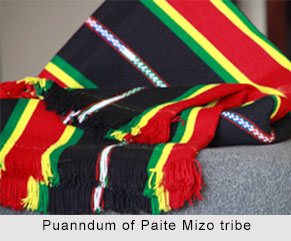 "Puanndum" is the term given to a dark black cloth produced by the Mizo Kuki tribes of Manipur ("Puan" meaning cloth; "Dum" meaning black). However, it is not commonly used by the Mizos.
"Puanndum" is the term given to a dark black cloth produced by the Mizo Kuki tribes of Manipur ("Puan" meaning cloth; "Dum" meaning black). However, it is not commonly used by the Mizos.
Design of Puanndum
Puanndum has a dark black background along with invariably weaved multicoloured bands across the length. Two length wise borders, about 10 centimetres wide, are kept red. These are next followed by bold bands of various colours such as blue, yellow, green, pink etc. The whole surface is covered wide with such bands of different breadths, interspersed over the fairly broad black background which also looks like bands in its overall appearance. Even though simple in respect of the intricacy in their designs, these Puanndums are highly colourful and exhibit artistic brilliance and craftsmanship in the arrangement of their bands. In weaving these puans, the wool which crosses the multicoloured threads, is stretched artistically lengthwise as the warp consists of deep black threads. This, in effect, makes the coloured bars look more vibrantly deep.
Relevance of Puanndum amongst the Mizos
Puanndum has a very deep cultural significance and it is indeed one of the few traditional Puans that retain their cultural hallow to a very large extent even today. In the earlier days, every girl was invariably required to weave at least one Puanndum so that she could carry it in her "Thul" (cane basket) at the time of her marriage. The possession of Puanndum by the newly married girls was so conceived as it is culturally linked with one of her sacred duties, which is to provide a distinctive cover for the dead body of her husband if he met his death during her lifetime. Puanndum assumes different names when used for different purposes. When used to cover a dead body, it takes the name "Thirin Puan" ("Thi" meaning "to die"); the name "Zawlpuan" if it is presented as a token of affection or love ("Zawl" meaning friendly); "Dawan-puan-phah" when the Puanndum is used by the parents of a girl as a bed spread to enable a boy friend of their daughter to sleep with her in their house, which implies an indirect consent of the parents to the couple to have pre-martial sexual relationship with the condition that they would subsequently marry, failing which the boy shall be fined.
Related Articles:
Manipur
Textiles of Manipur
Crafts of Manipur
Tribes of Manipur
Indian Costumes
Weaving and Dyeing Craft
Woollen Textiles, India
Textiles of Different Tribes of Manipur



















